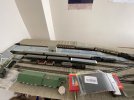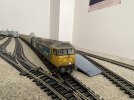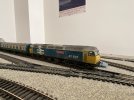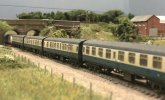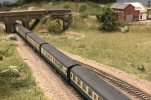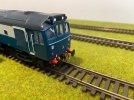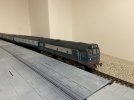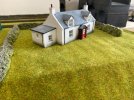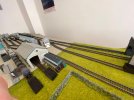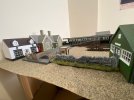Iskra
Established Member
Well, unfortunately I was struck down with the plague on the 23rd so I'm isolating through christmas. This is sub-optimal, but gives me chance to belatedly complete my locomotive advent calendar and could be a great opportunity to make progress on the layout too. Merry christmas everyone!
Day WD 2-8-0
A heavy freight locomotive that has seen better days, this locomotive can usually be seen on mineral, grain or van traffic. Occasionally, on a summer Saturday it can be seen on relief passenger services with any available spare rolling stock as unsuitable as it may be. This train is based on a historical service that ran on a summer Saturday on the Little North Western Line towards Morecambe, which was so crowded that at Keighley it stopped to pick up a suburban MK1 from the Oxenhope Branch before continuing to provide extra capacity. This loco is not prototypical in Scotland to my knowledge, but I've always liked them as austere work horses and it's one of my favourite locomotives that I've travelled behind at the KWVR. It was bought second hand, DCC Fitted and weathered.
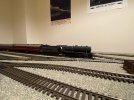
Day 9
A heljan class 26 takes on fuel at the shed. This is an all-rounder locomotive that can be seen on pretty much all traffic in the area.
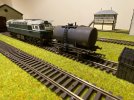
Day 10
DRS DCC Fitted Class 37. I did the weathering on this one and it looks okay I think. This loco is often seen running light or paired with the DRS class 20. It can run short engineers trains, nuclear flask trains, railtours and log trains. It's also a pretty handy substiute for anything that 'fails'. This loco features because I've travelled behind a number of DRS 37's on the mainline and it was available DCC fitted at a decent price.
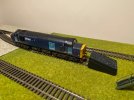
Day 101
DMU's are very useful on a smaller, end-to-end layout, which is why this one features more than what they would have done so prototypically. This is not the original one on the layout, as that was just a DC version- I upgraded to a DCC sound version when one became available at a good price. This DMU can run on the mainline, the branchline or can run through services from the Central Belt all the way to the port at the end of the branchline, with the minimum of operational fuss required compared to doing the same service involving a loco. It's pictured here having shunted on to a fish van that needs returning to the port.
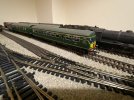
Day 122
While we're on the subject of DMU's... This is my first Dapol model on the railway. It came DCC fitted at a good price. Similar DMU's were used in Scotland. It's very useful on the branchline and works well in preserved mode too. It's a nice model and runs well.

Day 13
EWS Class 37 seen here arriving on the sleeper. It's a DCC sound loco and it's an excellent model. At some point I will hopefully do a decent light weathering job on it once I've sussed the airbrush. It works on the sleeper, lumber and engineering services in the area mainly.
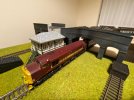
Day 14
The jinty. Another Bachmann DCC sound locomotive. It's an excellent runner. It came factory weathered, but then I did additional weathering to it. It's mainly used as station pilot or the odd trip working down the branch, sometimes it can be a not very suitable stand-in for a failed locomotive.
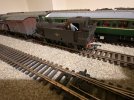
Day WD 2-8-0
A heavy freight locomotive that has seen better days, this locomotive can usually be seen on mineral, grain or van traffic. Occasionally, on a summer Saturday it can be seen on relief passenger services with any available spare rolling stock as unsuitable as it may be. This train is based on a historical service that ran on a summer Saturday on the Little North Western Line towards Morecambe, which was so crowded that at Keighley it stopped to pick up a suburban MK1 from the Oxenhope Branch before continuing to provide extra capacity. This loco is not prototypical in Scotland to my knowledge, but I've always liked them as austere work horses and it's one of my favourite locomotives that I've travelled behind at the KWVR. It was bought second hand, DCC Fitted and weathered.

Day 9
A heljan class 26 takes on fuel at the shed. This is an all-rounder locomotive that can be seen on pretty much all traffic in the area.

Day 10
DRS DCC Fitted Class 37. I did the weathering on this one and it looks okay I think. This loco is often seen running light or paired with the DRS class 20. It can run short engineers trains, nuclear flask trains, railtours and log trains. It's also a pretty handy substiute for anything that 'fails'. This loco features because I've travelled behind a number of DRS 37's on the mainline and it was available DCC fitted at a decent price.

Day 101
DMU's are very useful on a smaller, end-to-end layout, which is why this one features more than what they would have done so prototypically. This is not the original one on the layout, as that was just a DC version- I upgraded to a DCC sound version when one became available at a good price. This DMU can run on the mainline, the branchline or can run through services from the Central Belt all the way to the port at the end of the branchline, with the minimum of operational fuss required compared to doing the same service involving a loco. It's pictured here having shunted on to a fish van that needs returning to the port.

Day 122
While we're on the subject of DMU's... This is my first Dapol model on the railway. It came DCC fitted at a good price. Similar DMU's were used in Scotland. It's very useful on the branchline and works well in preserved mode too. It's a nice model and runs well.

Day 13
EWS Class 37 seen here arriving on the sleeper. It's a DCC sound loco and it's an excellent model. At some point I will hopefully do a decent light weathering job on it once I've sussed the airbrush. It works on the sleeper, lumber and engineering services in the area mainly.

Day 14
The jinty. Another Bachmann DCC sound locomotive. It's an excellent runner. It came factory weathered, but then I did additional weathering to it. It's mainly used as station pilot or the odd trip working down the branch, sometimes it can be a not very suitable stand-in for a failed locomotive.


